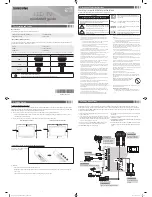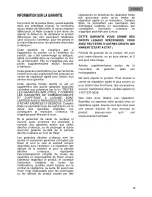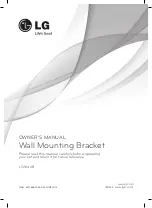
Service Modes, Error Codes, and Fault Finding
5.
•
Starter kit ComPair32/SearchMan32 software and
ComPair interface (excl. transformer): 3122 785 90450.
•
ComPair interface (excluding transformer): 4822 727
21631.
•
Starter kit ComPair32 software (registration version): 3122
785 60040.
•
Starter kit SearchMan32 software: 3122 785 60050.
•
ComPair32 CD (2003 update): 3122 785 60110.
•
SearchMan32 CD (2003 update): 3122 785 60120.
•
ComPair interface cable: 3122 785 90004.
•
ComPair firmware upgrade IC: 3122 785 90510.
•
Transformer Europe: 4822 727 21632.
•
Transformer UK: 4822 727 21633.
5.5
Error Codes
5.5.1
Introduction
The error code buffer contains all detected errors since the last
time the buffer was erased. The buffer is written from left to
right, new errors are logged at the left side, and all other errors
shift one position to the right.
When an error has occurred, the error is added to the list of
errors, provided the list is not full or the error is a protection
error.
When an error occurs and the error buffer is full, then the new
error is not added, and the error buffer stays intact (history is
maintained), except when the error is a protection error.
To prevent that an occasional error stays in the list forever, the
error is removed from the list after 50+ operation hours.
When multiple errors occur (errors occurred within a short time
span), there is a high probability that there is some relation
between them.
5.5.2
How to read the Error Buffer
Use one of the following methods:
•
On screen via the SAM (only if you have a picture).
Examples:
–
0 0 0 0: No errors detected
–
6 0 0 0: Error code 6 is the last and only detected error
–
9 6 0 0: Error code 6 was first detected and error code
9 is the last detected error
•
Via the blinking LED procedure (when you have no
picture). See next paragraph.
•
Via ComPair.
5.5.3
How to clear the Error Buffer
Use one of the following methods:
•
By activation of the “CLEAR ERRORS” command in the
SAM menu.
•
With a normal RC, key in sequence “MUTE” followed by
“062599” and “OK”.
•
When you transmit the commands “DIAGNOSE” - “99” -
“OK” with ComPair (or with a DST).
•
If the content of the error buffer has not changed for 50+
hours, it resets automatically.
5.5.4
Error Codes
Error codes are required to indicate failures in the TV set. In
principle a unique error is available for every:
•
I2C device error.
•
I2C bus error (for every bus containing two or more I2C
devices).
•
Protection error (e.g. +8V protection or Horizontal
protection).
•
Error not related to an I2C device, but of importance (e.g.
BC-loop, RAM error).
Table 5-1 Error Table
Service tips:
•
In case of non-intermittent faults, clear the error buffer
before you begin the repair. This to ensure that old error
codes are no longer present. Before clearing the buffer,
write down the content, as this history can give you
significant information.
•
If possible, check the entire contents of the error buffer. In
some situations, an error code is only the result of another
error code and not the actual cause (e.g., a fault in the
protection detection circuitry can also lead to a protection).
5.6
The Blinking LED Procedure
5.6.1
Introduction
Via this procedure, you can make the contents of the error
buffer visible via the front LED. This is especially useful for fault
finding, when there is no picture.
When the SDM is activated, the front LED will show (blink) the
contents of the error-buffer. Error-codes > 10 are shown as
follows:
1.
A long blink of 750 ms (which is an indication of the decimal
digit),
2.
A pause of 1500 ms,
3.
“n” short blinks (where “n” = 1 - 9),
4.
When all the error-codes are displayed, the sequence
finishes with a LED blink of 3000 ms,
5.
The sequence starts again.
Example: Error 12 9 6 0 0.
After activation of the SDM, the front LED will show:
1.
1 long blink of 750 ms (which is an indication of the decimal
digit) followed by a pause of 1500 ms,
2.
2 short blinks of 250 ms, followed by a pause of 3000 ms,
3.
9 short blinks of 250 ms, followed by a pause of 3000 ms,
4.
6 short blinks of 250 ms, followed by a pause of 3000 ms,
5.
1 long blink of 3000 ms to finish the sequence,
6.
The sequence starts again.
5.6.2
How to activate
Use one of the following methods:
•
Activate the SDM (only via soldering pads marked “FOR
SERVICE” on the SSB). The blinking front LED will show
the entire contents of the error buffer (this works in “normal
Error Description
0
No error
1
Horizontal Protection (via NOHFB bit in ADOC)
3
+8V error (missing/protection active by checking
MPIF ASUP bit))
4
X-ray/High beam current protection signal (via
XPROT bit in ADOC)
5
Hardware Protection is active (same as EMG)
7
Under-voltage protection
11
MPIF I2C communication failure / MPIF test failed
12
BC-loop not stabilised within the time limit (i.e. after
timer is expired)
13
NVM I2C communication failure
14
Main tuner I2C failure UV13xx
17
3D Combfilter I2C communication failure
18
PIP Tuner I2C failure
19
2fH component input I2C failure (PCF8574)
21
PIP IF demodulator IC TDA988x communication
failed (only for PIP/DW sets)
22
Flash over protection error (to register CRT flash-
overs, via FPR bit in ADOC)
Содержание A02E
Страница 82: ...www s manuals com ...









































